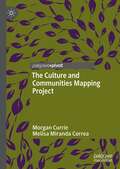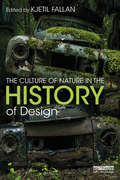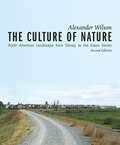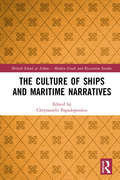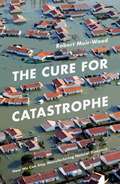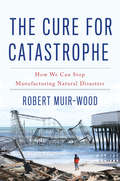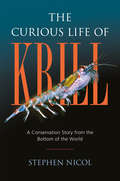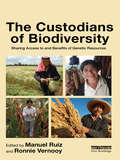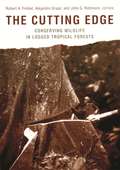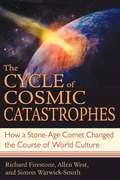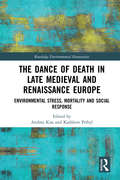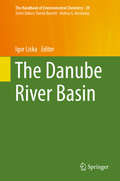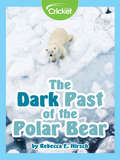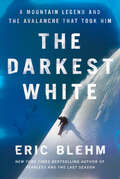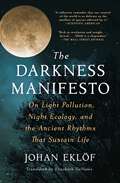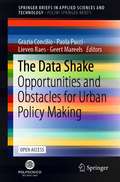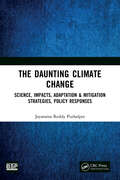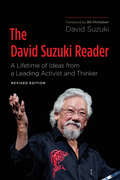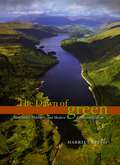- Table View
- List View
The Culture and Communities Mapping Project
by Morgan Currie Melisa Miranda CorreaThis book describes three years of work by the Culture and Communities Mapping Project, a research project based in Edinburgh that uses maps as an object of study and also a means to facilitate research. Taking a self-reflexive approach, the book draws on a variety of iterative mapping procedures and visual methodologies, from online virtual tours to photo elicitation, to capture the voices of inhabitants and their distinctive perspectives on the city. The book argues that practices of cultural mapping consist of a research field in and of itself, and it situates this work in relation to other areas of research and practice, including critical cartography, cultural geography, critical GIS, activist mapping and artist maps. The book also offers a range of practical approaches towards using print and web-based maps to give visibility to spaces traditionally left out of city representations but that are important to the local communities that use them. Throughout, the authors reflect critically on how, through the processes of mapping, we create knowledge about space, place, community and culture.
The Culture of Nature in the History of Design
by Kjetil FallanThe Culture of Nature in the History of Design confronts the dilemma caused by design’s pertinent yet precarious position in environmental discourse through interdisciplinary conversations about the design of nature and the nature of design. Demonstrating that the deep entanglements of design and nature have a deeper and broader history than contemporary discourse on sustainable design and ecological design might imply, this book presents case studies ranging from the eighteenth to the twenty-first century and from Singapore to Mexico. It gathers scholarship on a broad range of fields/practices, from urban planning, landscape architecture, and architecture, to engineering design, industrial design, furniture design and graphic design. From adobe architecture to the atomic bomb, from the bonsai tree to Biosphere 2, from pesticides to photovoltaics, from rust to recycling – the culture of nature permeates the history of design. As an activity and a profession always operating in the borderlands between human and non-human environments, design has always been part of the environmental problem, whilst also being an indispensable part of the solution. The book ventures into domains as diverse as design theory, research, pedagogy, politics, activism, organizations, exhibitions, and fiction and trade literature to explore how design is constantly making and unmaking the environment and, conversely, how the environment is both making and unmaking design. This book will be of great interest to a range of scholarly fields, from design education and design history to environmental policy and environmental history.
The Culture of Nature: North American Landscape from Disney to Exxon Valdez
by Alexander WilsonSince it was first published in 1991, few books have come close to capturing the depth and breadth of Alexander Wilson’s innovative ecocultural compendium The Culture of Nature. His work was one of the first of its kind to investigate the ideology of the environment, to critique the future according to Disney, and illustrate that the ways we think, teach, talk about, and construct the natural world are as important a terrain as the land itself. Extensively illustrated and meticulously researched, this edition is exquisitely revised and reissued for the Anthropocene.
The Culture of Ships and Maritime Narratives (British School at Athens - Modern Greek and Byzantine Studies #7)
by Chryssanthi PapadopoulouThe ship transcends the descriptive categories of place, vehicle and artefact; it is a cosmos, which requires its own cosmology. This is the subject matter of this volume, which falls within the broader, flourishing sub-field of maritime anthropology. Specifically, the volume first investigates the dialectic between the sea, the ship and the ship-dweller and shows how traits are exchanged between the three. It then focuses on land-dwellers, their understanding of seaborne existence and their invaluable contribution to the culture of ships. It shows that the romanticised views of life at sea that land-dwellers hold constitute an important aspect of the cosmology of ships and they too need to be considered if the polyvalence of ships is to be fully understood. In order for this cosmology to be written, some of the volume’s contributors have travelled on ships and interviewed mariners, fishermen, boat-builders and boat-dwellers; others have traced the courses of ships in poems, films, philosophical texts, and collective myths of genealogy and heritage. Overall the volume shows where ships can go, and how they are perceived and experienced by those living and travelling in them, watching and waiting for them, dreaming and writing about them, and, finally, what literal and metaphorical crews man them.
The Cure for Catastrophe: How We Can Stop Manufacturing Natural Disasters
by Robert Muir-WoodWhy did no one consider that a tsunami could disable the nuclear power plant in Fukushima? Why did so many die when Katrina flooded New Orleans? Not so long ago we could only focus on rescuing and sheltering survivors - now we can anticipate many natural disasters and plan for them. In dozens of cities around the world, we're able to identify the specific buildings that will be shaken apart, blown down or reduced to rubble. Yet every year, for reasons of politics and inertia, we fail to act. Despite a revolution in our understanding of these catastrophes, since 2000 they've killed more people than ever before.Taking us on a fascinating journey through the history of catastrophe science, with forensic examinations of the most devastating cataclysms in living memory, Robert Muir-Wood provides a riveting account of our attempts to tame the most extreme forces of nature. Combining a global span with insights from the latest climate and catastrophe modelling, The Cure for Catastrophe explores the extraordinary opportunity we now have to transform what we build, where we live and how warnings are communicated - decisions that could save millions of lives.
The Cure for Catastrophe: How We Can Stop Manufacturing Natural Disasters
by Robert Muir-WoodWe can't stop natural disasters but we can stop them being disastrous. One of the world's foremost risk experts tells us how.Year after year, floods wreck people's homes and livelihoods, earthquakes tear communities apart, and tornadoes uproot whole towns. Natural disasters cause destruction and despair. But does it have to be this way?In The Cure for Catastrophe, global risk expert Robert Muir-Wood argues that our natural disasters are in fact human ones: We build in the wrong places and in the wrong way, putting brick buildings in earthquake country, timber ones in fire zones, and coastal cities in the paths of hurricanes. We then blindly trust our flood walls and disaster preparations, and when they fail, catastrophes become even more deadly. No society is immune to the twin dangers of complacency and heedless development.Recognizing how disasters are manufactured gives us the power to act. From the Great Lisbon Earthquake of 1755 to Hurricane Katrina, The Cure for Catastrophe recounts the ingenious ways in which people have fought back against disaster. Muir-Wood shows the power and promise of new predictive technologies, and envisions a future where information and action come together to end the pain and destruction wrought by natural catastrophes. The decisions we make now can save millions of lives in the future.Buzzing with political plots, newfound technologies, and stories of surprising resilience, The Cure for Catastrophe will revolutionize the way we conceive of catastrophes: though natural disasters are inevitable, the death and destruction are optional. As we brace ourselves for deadlier cataclysms, the cure for catastrophe is in our hands.
The Curious Life of Krill: A Conservation Story from the Bottom of the World
by Stephen NicolKrill-it's a familiar word that conjures oceans, whales, and swimming crustaceans. Scientists say they are one of most abundant animals on the planet. But when pressed, few people can accurately describe krill or explain their ecological importance. Antarctic krill have used their extraordinary adaptive skills to survive and thrive for millions of years in a dark, icy world far from human interference. But with climate change melting ice caps at the top and bottom of the world, and increased human activity and pollution, their evolutionary flexibility to withstand these new pressures may not be enough.Eminent krill scientist Stephen Nicol wants us to know more about this enigmatic creature of the sea. He argues that it's critical to understand krill's complex biology in order to protect them as the krill fishing industry expands. This account of Antarctic krill-one of the largest of eighty-five krill species-takes us to the Southern Ocean to learn firsthand the difficulties and rewards of studying krill in its habitat. Nicol lays to rest the notion that krill are simply microscopic, shrimplikewhale food but are in fact midway up the food chain, consumers of phytoplankton and themselves consumed by whales, seals, and penguins. From his early education about the sex lives of krill in the Bay of Fundyto a krill tattoo gone awry, Nicol uses humor and personal stories to bring the biology and beauty of krill alive. In the final chapters, he examines the possibility of an increasingly ice-free Southern Ocean and what that means for the fate of krill-and us.Ocean enthusiasts will come away with a newfound appreciation for the complex ecology of a species we have much to learn from, and many reasons to protect.
The Custodians of Biodiversity: Sharing Access to and Benefits of Genetic Resources
by Ronnie Vernooy Manuel RuizGlobally, local and indigenous approaches to conserving biodiversity, crop improvement, and managing precious natural resources are under threat. Many communities have to deal with 'biopiracy,' for example. As well, existing laws are usually unsuitable for protecting indigenous and traditional knowledge and for recognizing collective rights, such as in cases of participatory plant breeding, where farmers, researchers and others join forces to improve existing crop varieties or develop new ones, based on shared knowledge and resources. This book addresses these issues. It outlines the national and international policy processes that are currently underway to protect local genetic resources and related traditional knowledge and the challenges these initiatives have faced. In particular these themes are addressed within the context of the Convention of Biological Diversity and the International Treaty on Plant Genetic Resources for Food and Agriculture. The authors broaden the policy and legal debates beyond the sphere of policy experts to include the knowledge-holders themselves. These are the 'custodians of biodiversity': farmers, herders and fishers in local communities. Their experience in sharing access and benefits to genetic resources is shown to be crucial for the development of effective national and international agreements. The book presents and analyzes this experience, including case studies from China, Cuba, Honduras, Jordan, Nepal, Peru and Syria. Copublished with the International Development Research Centre (IDRC).
The Cutting Edge: Conserving Wildlife in Logged Tropical Forests
by John G. Robinson Alejandro Grajal Robert A. FimbelBringing together leading scientists and professionals in tropical forest ecology and management, this book examines in detail the interplay between timber harvesting and wildlife, from invertebrates to large mammal species. Its contributors suggest modifications to existing practices that can ensure a better future for the tropics' valuable--and invaluable--resources.
The Cycle of Cosmic Catastrophes: How a Stone-Age Comet Changed the Course of World Culture
by Allen West Richard Firestone Simon Warwick-SmithNewly discovered scientific proof validating the legends and myths of ancient floods, fires, and weather extremes• Presents new scientific evidence revealing the cause of the end of the last ice age and the cycles of geological events and species extinctions that followed• Connects physical data to the dramatic earth changes recounted in oral traditions around the world • Describes the impending danger from a continuing cycle of catastrophes and extinctionsThere are a number of puzzling mysteries in the history of Earth that have yet to be satisfactorily explained by mainstream science: the extinction of the dinosaurs, the vanishing of ancient Indian tribes, the formation of the mysterious Carolina Bays, the disappearance of the mammoths, the sudden ending of the last Ice Age, and the cause of huge underwater landslides that sent massive tsunamis racing across the oceans millennia ago. Eyewitness accounts of these events are chronicled in rich oral traditions handed down through generations of native peoples. The authors’ recent scientific discoveries link all these events to a single cause.In The Cycle of Cosmic Catastrophes Richard Firestone, Allen West, and Simon Warwick-Smith present new scientific evidence about a series of prehistoric cosmic events that explains why the last Ice Age ended so abruptly. Their findings validate the ubiquitous legends and myths of floods, fires, and weather extremes passed down by our ancestors and show how these legendary events relate to each other. Their findings also support the idea that we are entering a thousand-year cycle of increasing danger and possibly a new cycle of extinctions.
The Dance of Death in Late Medieval and Renaissance Europe: Environmental Stress, Mortality and Social Response (Routledge Environmental Humanities)
by Kathleen Pribyl Andrea KissThis volume investigates environmental and political crises that occurred in Europe during the late Middle Ages and the early Modern Period, and considers their effects on people’s lives. At this time, the fragile human existence was imagined as a ‘Dance of Death’, where anyone, regardless of social status or age, could perish unexpectedly. This book covers events ranging from cooling temperatures and the onset of the Little Ice Age, to the frequent occurrence of epidemic disease, pest infestations, food shortages and famines. Covering the mid-fourteenth to mid-seventeenth centuries, this collection of essays considers a range of countries between Iceland (to the north), Italy (to the south), France (to the west) and the westernmost parts of Russia (to the east). This wide-reaching volume considers how deeply climate variability and changes affected and changed society in the late medieval to early modern period, and asks what factors, other than climate, interfered in the development of environmental stress and socio-economic crises. This book will be of great interest to students and scholars of Environmental and Climate History, Environmental Humanities, Medieval and Early Modern History and Historical Geography, as well as Climate Change and Environmental Sciences.
The Danube River Basin (The Handbook of Environmental Chemistry #39)
by Igor LiskaThis volume offers a comprehensive review of the chemical, biological and hydromorphological quality of the Danube. The first part examines the chemical pollution of surface waters, focusing on organic compounds (with special emphasis given to EU WFD priority substances and Danube River Basin specific pollutants), heavy metals and nutrients. Attention is also given to pollution of groundwater and drinking water resources by hazardous substances and to radioactivity in the Danube. The second part highlights the biology and hydromorphology of the Danube. It focuses on benthic macroinvertebrates, phytobenthos, macrophytes, fish, phytoplankton as well as microbiology, with chapters dedicated to gaps and uncertainties in the ecological status assessment and to invasive alien species. Further chapters dealing with the hydromorphology, sediment management and isotope hydrology complete the overall picture of the status of the Danube.
The Danube River Delta (Earth and Environmental Sciences Library)
by Abdelazim M. Negm Daniel Constantin DiaconuThis unique book presents for the first time the current status of the Danube River Delta, the challenges facing it, and proposed strategies to solve it. One of the biggest challenges is the human effects on the Danube Delta Environment and its lakes that work as sinks for natural and anthropogenic environmental changes, the water management and water flow variability and under climatic conditions including the extreme temperature and precipitation events based on RCMs output and the impact of sedimentation processes on the evolution of the Danube Delta. The book also contains the impact of wind and solar energy on the Delta. The book also presents the integrated approach for sustainable development of the Delta including the structural dynamics of the local economy, the role of tourism activities, integrated waste management in the Danube Delta Biosphere Reserve, demographic dynamics in the Delta, and the population health state. Also, a unique chapter on the opportunities of content exploitation as Language Learning Experiences is applied to Danube Delta. The book will be of great scientific interest to help the graduate students, researchers, stakeholder professional engineers, policy planners, policymakers of three countries to implement their sustainable development plan.
The Dark Horse: Nuclear Power and Climate Change
by Rauli Partanen Janne M. KorhonenClimate scientists consider climate change to be among top threats to humanity’s future. If unchecked, runaway climate change can destroy not just many of our current ecosystems, but wreak havoc in human societies as well. To prevent the worst catastrophe, greenhouse gas emissions from our energy system needs to decline to zero rapidly. We need to replace fossil fuels, which represent roughly 85 % of our energy production, with low-carbon alternatives. To manage this in a low-risk and timely manner, all tools need to be utilized to their maximum potential, including nuclear energy. Nuclear is surrounded by colourful rhetoric, politics, fear and fearmongering, click-bait scandal-headlines and mental images of dangerous radiation and catastrophic accidents. But how much of this is warranted, and how much is based on beliefs, opinions and prejudices? How dangerous is ionizing radiation really? What happened in Chernobyl and Fukushima, and what are the best estimates on their effects on public health and the environment? And can we harness nuclear energy to play a major role in decarbonizing our energy systems rapidly and more affordably? This book takes a serious look how the climate change mitigation is progressing, what needs to be done, and how nuclear has helped in the past, and can help us in the future. Partanen is an award-winning science writer and analyst on climate, environment, energy and society. Korhonen did his PhD in the history of technology, has written about climate and energy for years and is currently researching “Plan B”, an emergency program for climate change mitigation.
The Dark Past of the Polar Bear
by Rebecca E. HirschPolar bears rule the frozen sea, but their ancestors weren't always built for ice and snow.
The Dark!: Wild Life in the Mysterious World of Caves
by Lindsey LeighCrawl into the deepest corners of caves across the world and learn about the wonderfully weird creatures that live their lives in the dark!Did you know that some creatures that live in the dark have adapted to have no eyes? Or that some dark dwellers have extra long antennae so they can feel their way around their homes? Have you ever seen a troglobite? There many different types of troglobites including the fearless waterfall-climbing cave fish, the mutant Mexican tetra, and the mystifying olm.Author and illustrator Lindsey Leigh introduces young readers to some of the weirdest and creepiest critters that thrive in the darkest corners of our planet in her uniquely funny and graphic style. This fact-filled book reveals the different ways that creatures of the dark have adapted to thrive in their environments, including slow movement and loss of pigment in their bodies to blend in with their surroundings. Readers will get to know aquatic cave leeches, tailless whip scorpions, cave beetles, the devil&’s hole pupfish, worms, salamanders, and all kinds of bats.Praise for Lindsey Leigh's The Deep!&“A buoyant undersea venture. Leigh draws her teeming wildlife in accurate detail.&”--Kirkus Reviews, starred review
The Darkest White: A Mountain Legend and the Avalanche That Took Him
by Eric Blehm“Eric Blehm offers an insightful perspective on how Craig Kelly became the effortless icon that we all revered as well as sobering details of how his heroic journey tragically ended. The Darkest White is a must read, not just for fans of snowboarding, but for anyone looking for inspiration from an unlikely hero.”—Tony HawkFrom Eric Blehm, the bestselling author of The Last Season and Fearless, comes an extraordinary new book in the vein of Into the Wild, the story of the legendary snowboarder Craig Kelly and his death in the 2003 Durrand Glacier Avalanche—a devastating and controversial tragedy that claimed the lives of seven people.On January 20, 2003, a thunderous crack rang out and a violent tide of snow barreled down the northern Selkirk Mountains in British Columbia, Canada, burying thirteen skiers and snowboarders. Among them was Craig Kelly—“the Michael Jordan of snowboarding”—a world champion who had propelled the sport into the mainstream before walking away from competitions to rekindle his passion in the untamed alpine wilds of North America.The Darkest White tells the story of Craig Kelly’s life, an extraordinary and inspiring odyssey of a latchkey kid whose athletic prowess and innovations revolutionized winter sports, carried him around the globe, and pushed him into increasingly extreme backcountry environments. It is also a definitive, immersive account of how snowboarding grew from a minor Gen X cult hobby to Olympic centerpiece and a billion-dollar business full of feuds and rivalries. This mesmerizing tribute is a cautionary portrait of the mountains, of the allure and the glory they offer, and of the avalanches they unleash with unforgiving fury."The most unremittingly exciting book of nonfiction I have come across in recent years. I found myself reading late into recent nights wholly transfixed by every paragraph, every word."—Simon Winchester, New York Times Book Review
The Darkness Manifesto: On Light Pollution, Night Ecology, and the Ancient Rhythms that Sustain Life
by Johan EklöfIn the bestselling tradition of Why We Sleep and The Sixth Extinction, an urgent and insightful look at the hidden impact of light pollution, and a passionate appeal to cherish natural darkness for the sake of the environment, our own well-being, and all life on earth.How much light is too much light? Satellite pictures show our planet as a brightly glowing orb, and in our era of constant illumination, light pollution has become a major issue. The world&’s flora and fauna have evolved to operate in the natural cycle of day and night. But in the last 150 years, we have extended our day—and in doing so have forced out the inhabitants of the night and disrupted the circadian rhythms necessary to sustain all living things, including ourselves. In this persuasive, well-researched book, Swedish conservationist Johan Eklöf urges us to appreciate natural darkness, its creatures, and its unique benefits. Eklöf ponders the beauties of the night sky, traces the errant paths of light-drunk moths and the swift dives of keen-eyed owls, and shows us the bioluminescent creatures of the deepest oceans. As a devoted friend of the night, he writes passionately about the startling damage we inflict on ourselves and our fellow creatures simply by keeping the lights on. The Darkness Manifesto depicts the domino effect of diminishing darkness: insects, dumbfounded by streetlamps, failing to reproduce; birds blinded and bewildered by artificial lights; and bats starving as they wait in vain for food insects that only come out in the dark of night. For humans, light-induced sleep disturbances impact our hormones and weight, and can contribute to mental health problems like chronic stress and depression. The streetlamps, floodlights, and neon signs of cities are altering entire ecosystems, and scientists are only just beginning to understand the long-term effects. The light bulb—long the symbol of progress and development—needs to be turned off. Educational, eye-opening, and ultimately encouraging, The Darkness Manifesto outlines simple steps that we can take to benefit ourselves and the planet. In order to ensure a bright future, we must embrace the darkness.
The Data Shake: Opportunities and Obstacles for Urban Policy Making (SpringerBriefs in Applied Sciences and Technology)
by Grazia Concilio Paola Pucci Lieven Raes Geert MareelsThis open access book represents one of the key milestones of PoliVisu, an H2020 research and innovation project funded by the European Commission under the call “Policy-development in the age of big data: data-driven policy-making, policy-modelling and policy-implementation”. It investigates the operative and organizational implications related to the use of the growing amount of available data on policy making processes, highlighting the experimental dimension of policy making that, thanks to data, proves to be more and more exploitable towards more effective and sustainable decisions. The first section of the book introduces the key questions highlighted by the PoliVisu project, which still represent operational and strategic challenges in the exploitation of data potentials in urban policy making. The second section explores how data and data visualisations can assume different roles in the different stages of a policy cycle and profoundly transform policy making.
The Dating Game: One Man's Search for the Age of the Earth
by Cherry LewisFeaturing shedworkers and shedbuilders from around the world who are leading the alternative workplace revolution, Shedworking looks at why having a shed office is a greener way of working, improves the work-life balance, and accelerates one's productivity. Inspired by the author#145;s Shedworking website, which has been internationally acclaimed for the groundbreaking scale of its architectural coverage, the book features many previously unpublished images of garden offices and shed-like atmospheres: offices on roofs, sheds inside "traditional" offices, and even sheds on wheels, as well as cutting-edge Le Corbusier-designed models for the back garden, all-glass shed offices, and buildings "built" using living trees. Along the way it offers a whistle-stop tour of famous sheds from Pliny the Younger#145;s summerhouse and the retreats of 19th-century composers Edvard Grieg and Gustav Mahler to award-winning 21st-century fantasy writer Neil Gaiman's gazebo. In short, Shedworking offers a manifesto for those wanting to change their working lives for the better and go to work in the garden.
The Daunting Climate Change: Science, Impacts, Adaptation & Mitigation Strategies, Policy Responses
by Jayarama Reddy PuthalpetThe book starts with an overview of Climate Science. It discusses the signs of Warming, the impacts and consequences on several sectors - terrestrial and coastal ecosystems, water resources, ocean systems, agriculture, food production and food security, human health and safety, livelihoods and poverty, Arctic populations, low-lying States, so on. Mathematical models to project future climate and the resulting concerns, global adaptation experiences, and opportunities for future execution are explained. The mitigation approaches, chiefly decarbonizing the energy sector by developing and applying clean/low carbon energy sources and improving energy efficiency, and the evolving geoengineering schemes are dealt. Carbon pricing, an economic tool to ensure emissions reductions, and transition to a low carbon economy to stimulate sustainable growth are described. The continued global efforts under the UN or otherwise until the recent Paris Agreement to arrive at policy responses to tackle this intriguing but daunting problem of climate change are vividly expounded. Note: T&F does not sell or distribute the hardback in India, Pakistan, Nepal, Bhutan, Bangladesh and Sri Lanka.
The David Suzuki Reader
by Bill Mckibben David SuzukiIn this revised and expanded edition of his collected writings, David Suzuki continues to explore the themes that have informed his work for more than four decades - the interconnectedness of all things, our misguided elevation of economics above all else, the urgent need to deal with climate change - but with an increased emphasis on solutions to the myriad problems we face, his inspiring vision for the future, and the legacy he hopes to leave behind. There is also more emphasis on the personal, as he recounts episodes from his childhood and early adulthood and speaks eloquently about old age, death, and the abiding role of nature and family in his life. Written with clarity, passion, and wisdom, this book is essential for anyone who is an admirer of David Suzuki, who wants to understand what science can and can't do, or who wants to make a difference.
The David Suzuki Reader
by David SuzukiDavid Suzuki’s collected writings on science, nature, technology, economics, politics, and the connectedness of all things. The David Suzuki Reader brings together for the first time the scientific and philosophical thought of North America’s leading environmentalist. Drawing from Suzuki’s published and unpublished writings, this collection reveals the underlying themes that have informed his work for over four decades. In these incisive and provocative essays, Suzuki explores the limits of knowledge and the connectedness of all things; looks unflinchingly at the destructive forces of globalization, political shortsightedness, and greed; cautions against blind faith in science, technology, politics, and economics; and provides inspiring examples of how and where to make those changes that will matter to all of us and to future generations. He also offers a vision of hope based on our love of children and nature. In this time of global unrest and uncertainty, Suzuki provides an important reminder of how we are all connected and of what really matters. Written with clarity, passion, and wisdom, this book is essential reading for anyone who is an admirer of David Suzuki, who wants to understand what science can and can’t do, or who wants to make a difference.
The Dawn Angiosperms
by Xin WangThis book is about fossil plants of so-called "pre-historic" angiosperms. It reflects the newest progress in research on the origin of angiosperms, and will definitely trigger many new ideas in research. It emphasizes the early Cretaceous and Jurassic materials, rather than later ones, as they are the key periods for the origin of angiosperms. The author integrates multiple techniques, including SEM, TEM, light microscopy, peeling and cladistics, to study the morphology, anatomy and phylogeny of the fossils. Several Jurassic materials of angiosperms that have never been reported before are included, these used to be thought as pre-historic for flowering plants. Two more fossils angiosperms from the Yixian Formation, where Archaefructus was excavated, are reported. Newer and stricter criterion for identifying fossil angiosperms is proposed.
The Dawn of Green: Manchester, Thirlmere, and Modern Environmentalism
by Harriet RitvoLocated in the heart of England's Lake District, Thirlmere, with its placid sheen, surrounding evergreens, and apparent lack of pollution or development, seems to epitomize the unadulterated bucolic ideal. But under its calm surface lurks the enduring legacy of a nineteenth-century conflict that pitted industrial progress against natural conservation--and helped launch the environmental movement as we know it. Purchased by the city of Manchester in the 1870s, Thirlmere was dammed and converted into a reservoir, its water piped 100 miles south to the burgeoning industrial city and its workforce. This feat of civil engineering--and of natural resource diversion--inspired one of the first environmental struggles of modern times. The Dawn of Green recreates the battle for Thirlmere and the clashes between conservationists who wished to preserve the lake and developers eager to supply the needs of industry and a growing urban population. Bringing to vivid life the colorful and strong-minded characters who populated both sides of the debate, noted historian Harriet Ritvo revisits notions of the natural promulgated by Romantic poets, recreationists, resource managers, and industrial developers to establish Thirlmere as the template for subsequent--and continuing--environmental struggles. A century after Thirlmere, the demand for water and the control of water rights are among the most pressing political, humanitarian,and environmental concerns of our time. By investigating Victorian ideas about industry, development, and technology, Ritvo shows how the lessons learned in the Lake District can inform and guide modern environmental and conservation campaigns.
